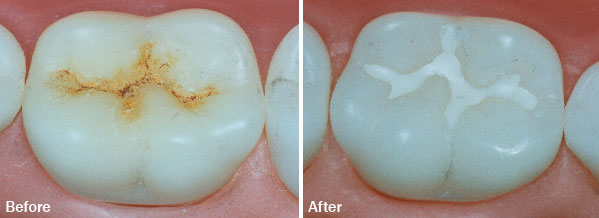Pit and Fissure Sealants in Trivandrum, Kerala
Pit And Fissure Sealants - Dr. Kashi’s Ashwathi Dental Clinic
Sealants, also referred to as dental sealants, consist of a plastic material that is placed on the chewing (occlusal) surface of the permanent back teeth — the molars and premolars — to help protect them from bacteria and acids that contribute to tooth decay.
Thorough brushing and flossing helps remove food particles and plaque from the smooth surfaces of teeth, but toothbrushes can't reach all the way into the depressions and grooves to extract all food and plaque. While fluoride helps prevent decay and helps protect all the surfaces of the teeth, dental sealants add extra protection for the grooved and pitted areas.
Why Your Child Might Need SealantsEven though pits and fissues do occur naturally, they can deepen over time, leading to dental caries, so a child whose teeth show signs of pits and fissures may be a prime candidate for dental sealants. Pits are small hollows that occur on the biting surfaces of permanent teeth, as described by the International Dental Health Foundation, whereas fissures are grooves in the outside of the tooth's surface. In both cases, these areas can easily fill with bacteria, which may be difficult to remove with regular oral hygiene.
As this bacteria grows, it interacts with the starches in the food you eat, turning them into acids that can eat away at tooth enamel. If this process causes enough decay, it eventually spreads to the inner pulp of the tooth. This can result in extremely painful and unsightly damage, which can cause lifelong dental problems.

Dental sealants work to coat and seal the grooves and hollows, preventing even the most the harmful bacteria from building up on the tooth. The size and depth of the hollows and grooves in your child's teeth will determine whether he or she can benefit from the application of a sealant. These sealants are typically used on the molars and premolars at the back of the mouth, as these are the teeth that most frequently develop surface irregularities.
